Habichuelas Guisadas (Stewed Beans) is one of the most popular recipes in the Dominican Republic. This stewed Dominican beans side dish is prepared quickly and uses simple ingredients commonly found in the kitchen.
If there’s one thing about Dominican cuisine, you’ll usually see beans involved in one way or another. The national dish of the Dominican Republic, La Bandera Dominicana, consists of meat, rice, and beans. La Bandera Dominicana, meaning the Dominican flag, represents the flag based on each ingredient, and beans represent the red or blood of the heroes.
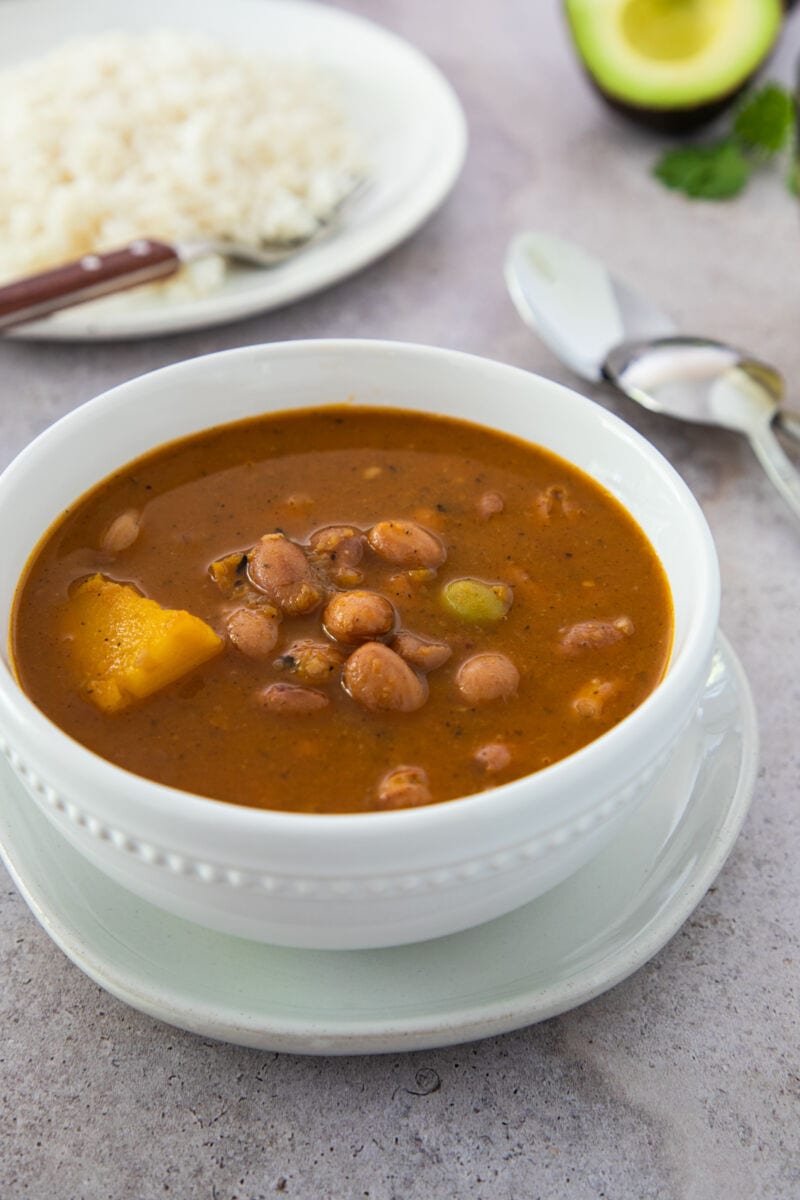
That said, beans are significant to both Dominican cuisine and the overall culture. Habichuelas guisadas is a popular side dish in various Dominican recipes, but it’s also known in Puerto Rican cuisine.
I’d like to show you how to make this well-renowned yet straightforward recipe. Your rice will love it!
Why You’ll Love This Recipe
The next time you make a dish with something that involves rice and a protein of your choice, try adding beans to it and see how it spices up the flavor. Habichuelas guisadas are simmered in a broth full of tomato sauce, pepper, onion, and many other ingredients that give the beans a vibrant flavor.
Presales are open!
The Dominican Kitchen is a collection of 80+ authentic recipes created with easy-to-find ingredients and featuring comforting traditional Dominican flavors. As a thank you to anyone who pre-orders a copy, we are giving out a FREE preorder bundle. Check out our cookbook page for more details.

The thickness and moisture of the habichuelas guisadas also add some extra juice to your meal when it feels too dry. Beans, in general, are also a great source of fiber and potassium to your diet, and it’s super easy to make!
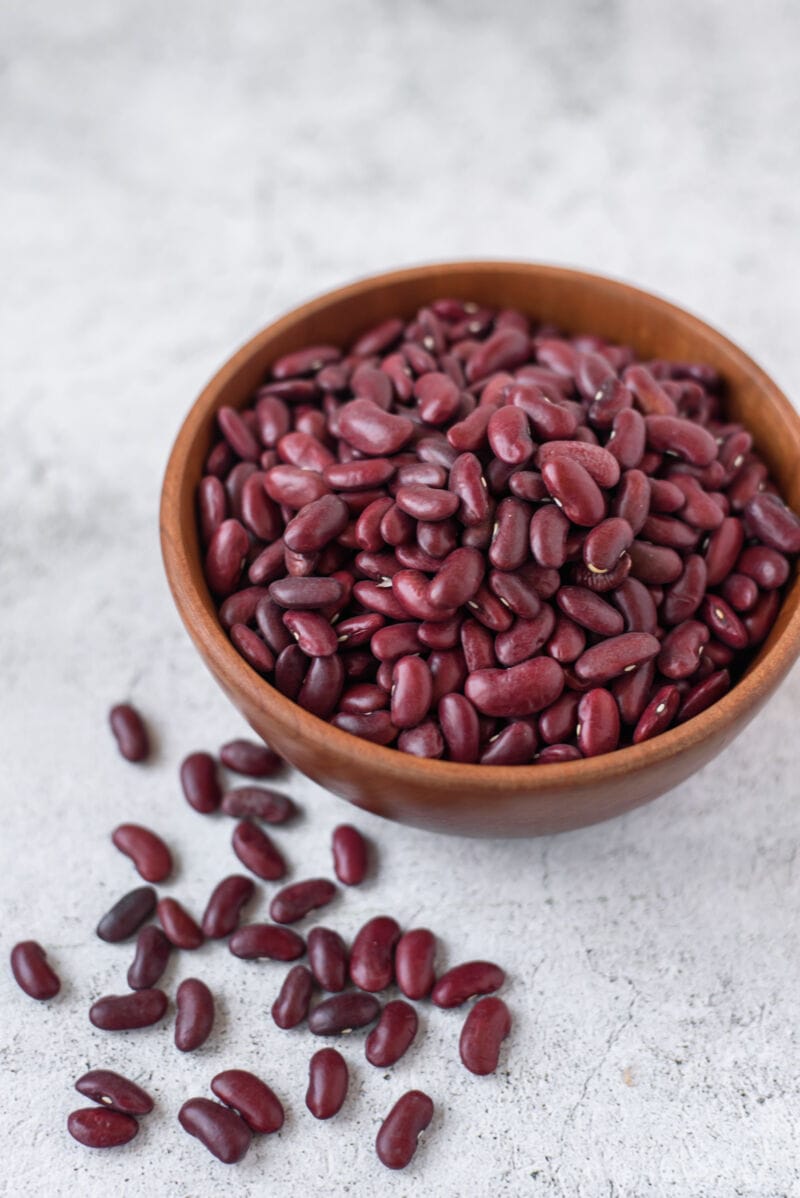
Ingredients
- Beans – You can use Red Dominican beans, Pinto, or Roman beans for this recipe. This recipe calls for canned beans for ease, but you can use dried beans as well. Just be sure to cook the beans in water to soften them before making this recipe.
- Garlic cloves – I press the garlic lightly to release the flavors a bit and add it whole when cooking. I later remove it when the dish is ready. You can also use mashed or minced garlic.
- Vegetable oil – Any vegetable oil works well for this recipe.
- Onion – I prefer red onion. Yellow onion works well too.
- Green or red bell pepper – Another option is Cubannele peppers.
- Culantro (cilantro ancho) – This herb is common in Dominican cooking, often added to soups and stews.
- Cilantro – Always a part of our sofrito base and flavor profile.
- Chicken bouillon tablet – You can use the tablet or granulated kind. You can also use vegetable bouillon for a vegetarian or vegan option.
- Annatto (Bija) – Adds flavor and color!
- Tomato sauce – Adds color and flavor to the stew.
- Pitted olives – You can use pitted olives or alcaparrado.
- Dried oregano – Dominican oregano is always my preferred oregano.
- Ground black pepper – Freshly cracked or ground is fine.
- Kabocha Squash (auyama) – It gives the beans a slight sweetness and helps thicken the broth slightly.
- Fresh lime juice – Adds freshness and balances the flavors.
- Salt to taste (optional) – The chicken bouillon contains salt, so be sure to taste and add salt only if needed.
Step-by-Steps Instructions
Prepare the sofrito sauce. Heat oil in a medium saucepan over medium-high heat. Press garlic cloves lightly with the flat part of a chef’s knife to break them a bit. Cook and stir the garlic, onion, bell pepper, culantro, cilantro, chicken bouillon, annatto, tomato sauce, olives, oregano, and black pepper for about 5 minutes, or until the onion begins to soften.
Cook the beans in the sauce. Stir in the beans with the juice and water. Bring to a boil and then add the squash. Lower the heat to medium and let simmer for about 15 minutes, or until the liquid reduces to ¾ and thickens a bit. Remove the garlic, onion, bell pepper, culantro, and cilantro from the pot and discard them. Stir in fresh lime juice and any additional salt to taste, if desired.
Presales are open!
The Dominican Kitchen is a collection of 80+ authentic recipes created with easy-to-find ingredients and featuring comforting traditional Dominican flavors. As a thank you to anyone who pre-orders a copy, we are giving out a FREE preorder bundle. Check out our cookbook page for more details.

How do you make Dominican beans from scratch?
Back then, Dominicans would indulge in a long process of making Dominican beans from scratch by harvesting red, pink, or pinto beans and then boiling them until they got soft. Just like I show in this recipe, they would also season them in a broth with traditional spices. In most cases, Dominicans would have to start the night before to get ahead in an hours-long process. With the availability of canned beans, we’re able to skip that process and get right to it.
However, if you want to make Dominican beans from scratch using dried beans, you most definitely can. You’ll want to soak the dry beans overnight. Then, boil them in plenty of water for about 1-2 hours, or until soft. You will need to add more water throughout the boiling process so that the beans do not become too dry or they can burn.
Once the beans are soft, you can follow this recipe as written. If you have leftover soft beans, place them in an airtight container or freezer bag and place in the freezer to store it for up to 3 months.
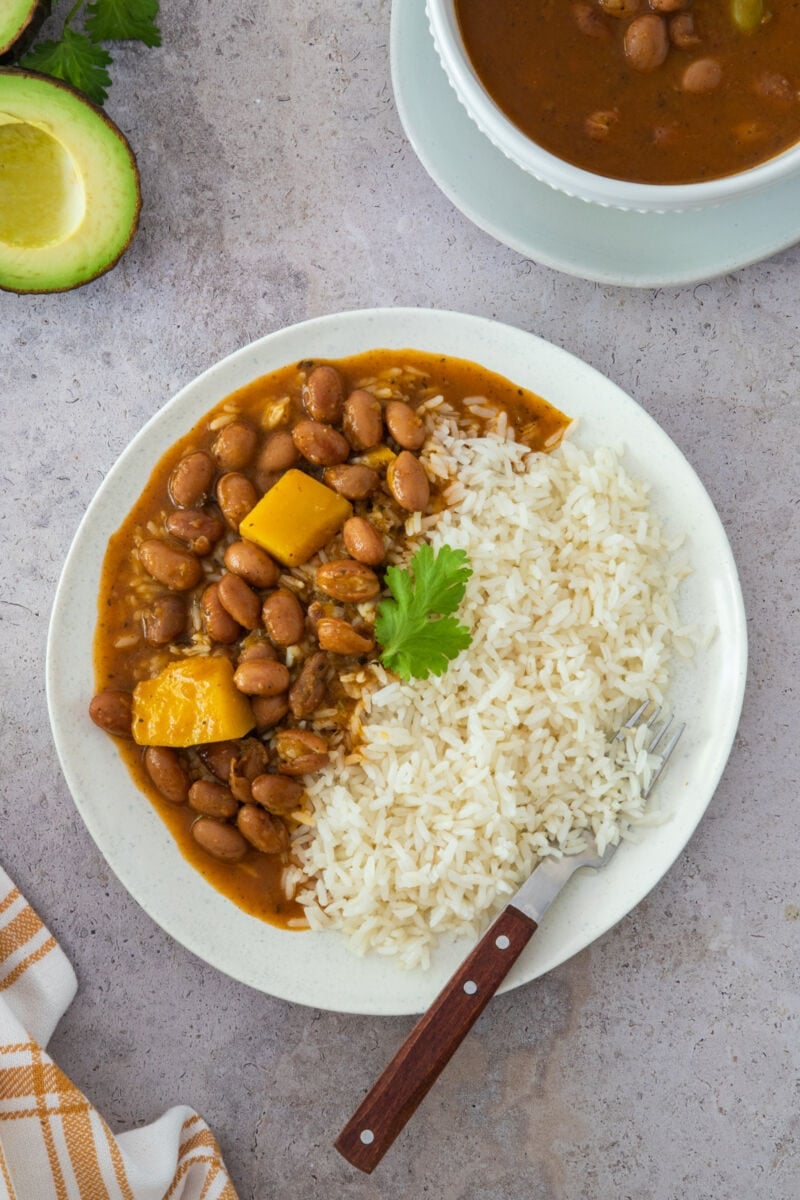
Serving Suggestions
Habichuelas guisadas is a great side dish to serve on top of white rice. You can eat this with my pollo guisado recipe with rice for some extra juice and fiber in your meal. It’s also great to have with concon to balance out the crunchiness of the rice.
Recipe Variations
- Instead of placing the culantro, cilantro, onions, and garlic, you can try swapping them with sofrito. Prepare a batch of sofrito and freeze it into ice cubes to drop into the broth. About 3 – 4 tablespoons or 2 -3 cubes will work for this recipe.
- Potato is also a great addition to add to your recipe for a thicker consistency and just having those little bits of it in your meal. Other ingredients that add great taste and texture to the beans are green plantains and auyama (squash).
Storage Tips
Dominicans will often leave their beans in the saucepan on the stove until it cools down to room temperature and then put them in the refrigerator until they’re ready to have more the next day. But leftover habichuela guisadas should generally be left in the fridge for up to 5 days or frozen for three months, and make sure it’s completely cooled down before storing.
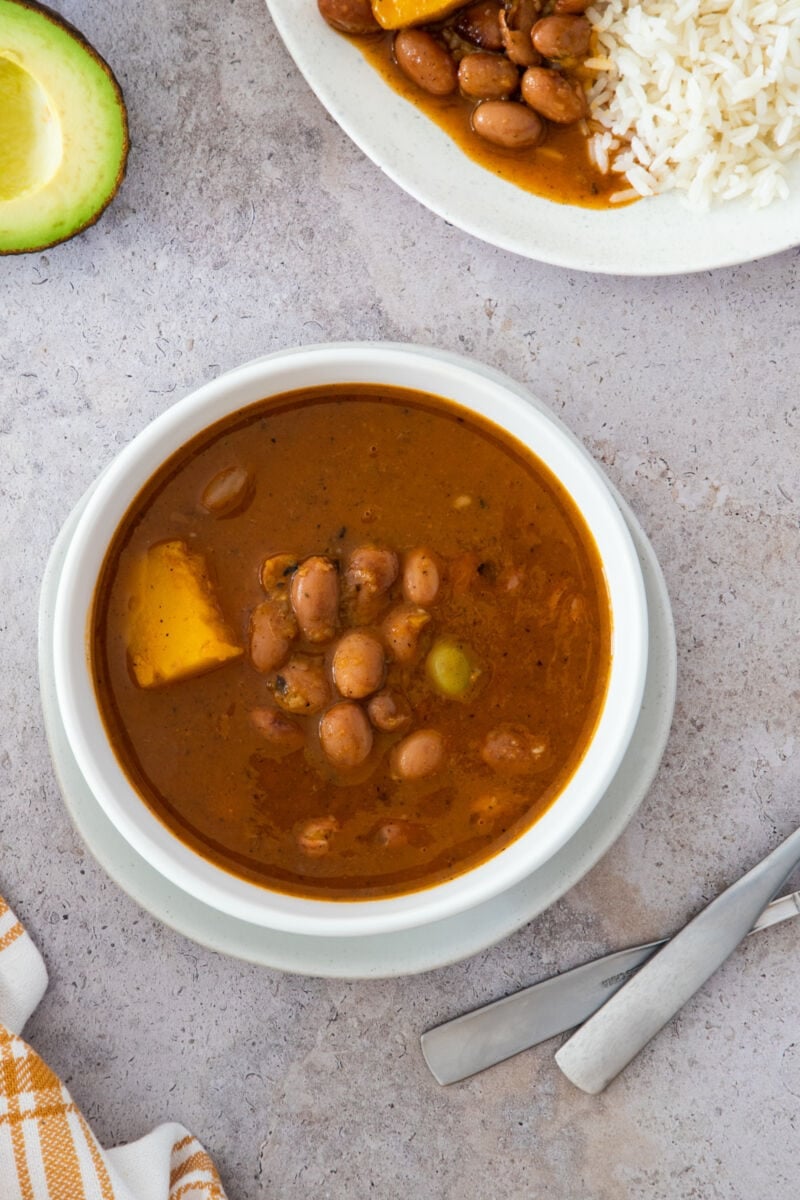
Frequently Asked Questions
Can I Use Canned Beans?
Yes! You can use whatever beans you have available, whether dry or canned. There is no soaking necessary for canned beans.
What type of beans should I use?
You can make this recipe with either red kidney beans, pinto, or roman beans. Some have also used pink beans for this recipe if you’re interested in that too. You can use black beans as well.
What is the difference between habichuelas and frijoles?
Among different cultures, frijoles and habichuelas can be referred to differently. Sometimes, both are the exact same thing. When translated, both actually mean bean, however, habichuela can also be translated to green bean. Overall, when trying to figure out what to refer to, it depends on who you’re talking to and where they’re from.
Recipe Notes and Tips
- To prepare this recipe, I use canned beans for ease and convenience, but you can use dried beans if you’d like. Soak the dry beans overnight. Then, boil the dry beans in water for about 1-2 hours, or until they become tender, before cooking this recipe.
- You can use red beans, pinto beans, or Roman beans to make this recipe. Pink beans and even black beans also work well with this recipe.
Other Recipes You’ll Love
- Easy Arroz Con Gandules Recipe (Rice with Pigeon Peas)
- Pollo Guisado Dominicano (Dominican Stewed Chicken Recipe)
- Easy Black Beans and Rice Recipe (Arroz Congri)
- Locrio de Salami (Dominican Rice with Salami)
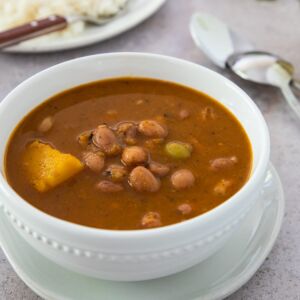
Dominican Beans (Habichuelas Guisadas)
Author:Equipment
Ingredients
- 1 tablespoon vegetable oil
- 2 garlic cloves, peeled
- ¼ medium onion, in one piece
- ¼ medium red bell pepper, in one piece
- 3 leaves culantro
- 1 tablespoon cilantro, in its stem
- ½ chicken bouillon tablet
- ½ teaspoon ground annatto
- 2 tablespoons tomato sauce
- 1 tablespoon pitted olives
- 1 teaspoon dried oregano
- ¼ teaspoon ground black pepper
- 1 can (15.5 ounces) Red, Pinto, or Roman beans, with its juices
- 2 ounces Kabocha squash, cubed
- 2 cups water
- 1 tablespoon fresh lime juice
- Salt to taste (optional)
Instructions
- Heat oil in a medium saucepan over medium-high heat.
- Press garlic cloves lightly with the flat part of a chef’s knife to break it a bit.
- Cook and stir the garlic, onion, bell pepper, culantro, cilantro, chicken bouillon, annatto, tomato sauce, olives, oregano, and black pepper for about 5 minutes, or until the onion begins to soften.
- Stir in beans with its juices and water. Bring to a boil and then, add in the squash.
- Lower the heat to medium and let simmer for about 15 minutes, or until the liquid reduces to ¾ and begins to thicken a bit.
- Remove the garlic, onion, bell pepper, culantro, and cilantro from the pot and discard.
- Stir in fresh lime juice and any additional salt to taste, if desired.
- Serve as a side dish with white rice and your favorite meat dish.
Notes
- To prepare this recipe, I use canned beans for ease and convenience, but you can use dried beans if you’d like. Soak the dry beans overnight. Then, boil the dry beans in water for about 1-2 hours, or until they become tender, before cooking this recipe.
- You can use red beans, pinto beans, or Roman beans to make this recipe. Pink beans and even black beans also work well with this recipe.
Nutrition
The nutritional information of this recipe and all recipes on mydominicankitchen.com is only an estimate. The accuracy of any recipe on this site is not guaranteed.

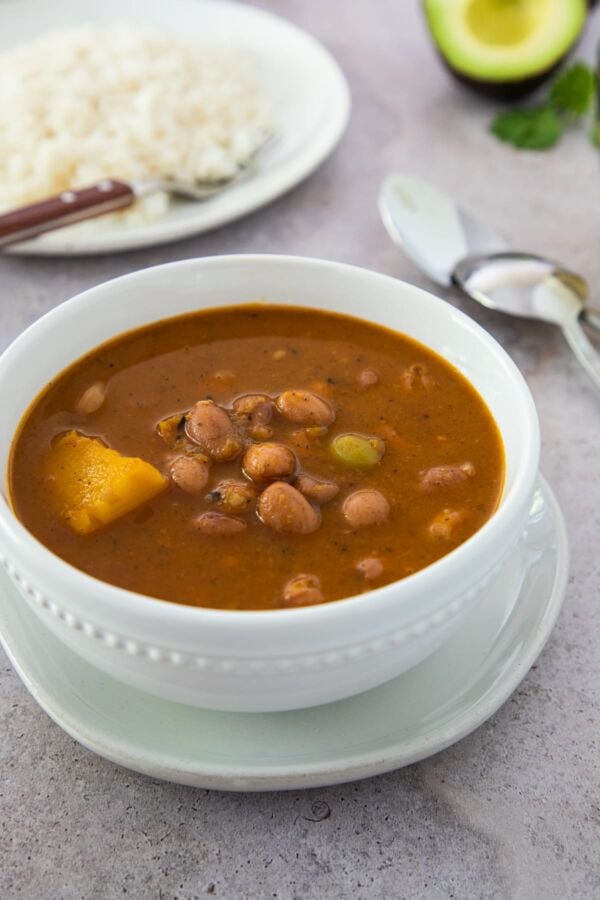
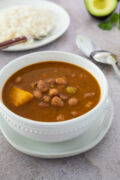

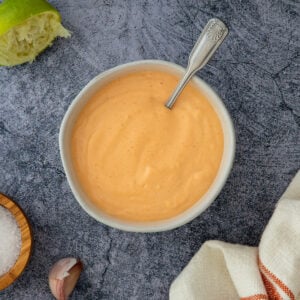

Let us know your thoughts!